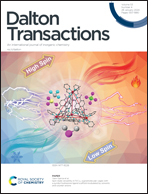Insight into the generation of near infra-red (NIR) absorbing species in electrochromic surface-anchored metal–organic frameworks†
Abstract
Due to their versatility and easy processing, Surface-Anchored Metal–Organic Frameworks (SurMOFs) have gained interest in recent times as promising electrochromic thin films. Herein a step forward in their use and characterization was achieved thanks to the integration of {Zn2(PDICl4)2} SurMOFs in a multi-layer electrochromic device (ECD), based on a membrane-like electrolyte. The optical and electrochemical properties of the ECD were fully characterized, revealing a two-step reduction process localized on the organic ligand and involving subsequent near infra-red (NIR) and cyan absorbing states, leading to optical modulation of the films. The species responsible for this absorption were isolated and identified in the reduced states. In parallel to experimental characterization, quantum chemistry was successfully used to investigate the structure–property relationship of the SurMOF, revealing additional information regarding the structure and the local environment of the electrochromic ligand.



 Please wait while we load your content...
Please wait while we load your content...